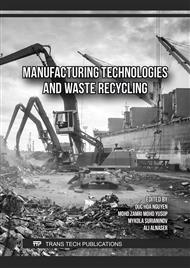[1]
Navarro M., Michiardi A., Castaño O., and Planell J.A. Biomaterials in orthopaedics, Journal of the Royal Society Interface, 5 (2008) 1137-1158.
DOI: 10.1098/rsif.2008.0151
Google Scholar
[2]
Radzali Othman, Zaleha Mustafa, Nor Fatiha Ishak, Pham Trung Kien, Zurina Shamsudin, Zulkifli Mohd Rosli, Ahmad Fauzi Mohd Noor, Intermediate Phases Formed during Synthesis of β-Tricalcium Phosphate via Wet Precipitation and Hydrothermal Methods, Journal of Advanced Research in Fluid Mechanics and Thermal Sciences, 2 (2018) 141-147.
DOI: 10.4028/www.scientific.net/ssp.264.132
Google Scholar
[3]
Elias C, Lima J, Valiev R, et al. Biomedical applications of titanium and its alloys, The journal of the Minerals, Metals & Materials Society, 60 (2008) 46–49.
Google Scholar
[4]
Albrektsson T, Branemark PI, Hansson HA, et al. Osseointegrated titanium implants: Requirements for ensuring a long lasting, direct bone-to-implant anchorage in man, Acta Orthop Scand, 52 (1981) 155-170.
DOI: 10.3109/17453678108991776
Google Scholar
[5]
Li YH, Yang C, Zhao HD, et al. New developments of Ti-based alloys for biomedical applications, Materials, 7 (2014) 1709–1800.
Google Scholar
[6]
Albrektsson T and Johansson C. Osteoinduction, osteoconduction and osseointegration, Eur Spine J, 10 (2001) 96–101.
Google Scholar
[7]
Sul YT, The significance of the surface properties of oxidized titanium to the bone response: Special emphasis on potential biochemical bonding of oxidized titanium implant, Biomaterials, 24 (2003) 3893–3907.
DOI: 10.1016/s0142-9612(03)00261-8
Google Scholar
[8]
Kasemo B and Gold J. Implant surfaces and interface processes, Adv Dent Res, 13 (1999) 8–20.
DOI: 10.1177/08959374990130011901
Google Scholar
[9]
Oyane A, Kim HM, Furuya T, et al. Preparation andassessment of revised simulated body fluids, J Biomed Mater Res A, 65 (2003) 188–195.
Google Scholar
[10]
Havelin L.I., Engesaeter L.B., Espehaug B., Furnes O., Lie S.A., and Vollset S.E, The Norwegian Arthroplasty Register: 11 years and 73,000 arthroplasties, Acta Orthop Scand, 71 (2000) 337-53.
DOI: 10.1080/000164700317393321
Google Scholar
[11]
Udoh K., Munar M.L., Maruta M., Matsuya S., and Ishikawa K. Effects of sintering temperature on physical and compositional properties of alphatricalcium phosphate foam, Dent Mater J, 29(2010) 154-9.
DOI: 10.4012/dmj.2009-079
Google Scholar
[12]
Fujisawa K., Akita K., Fukuda N., Kamada K., Kudoh T., Ohe G., Mano T., Tsuru K., Ishikawa K., and Miyamoto Y. Compositional and histological comparison of carbonate apatite fabricated by dissolution–precipitation reaction and Bio-Oss®, Journal of Materials Science: Materials in Medicine, 29 (2018) 121.
DOI: 10.1007/s10856-018-6129-2
Google Scholar
[13]
Kuroda K. and Okido M. Hydroxyapatite Coating of Titanium Implants Using Hydroprocessing and Evaluation of Their Osteoconductivity, Bioinorganic Chemistry and Applications, 2012 (2012) 1-7.
DOI: 10.1155/2012/730693
Google Scholar
[14]
Nagai H., Kobayashi-Fujioka M., Fujisawa K., Ohe G., Takamaru N., Hara K., Uchida D., Tamatani T., Ishikawa K., and Miyamoto Y. Effects of low crystalline carbonate apatite on proliferation and osteoblastic differentiation of human bone marrow cells, J Mater Sci Mater Med, 26 (2015) 26:99.
DOI: 10.1007/s10856-015-5431-5
Google Scholar
[15]
Verwilghen C., Chkir M., Rio S., Nzihou A., Sharrock P., and Depelsenaire G. Convenient conversion of calcium carbonate to hydroxyapatite at ambient pressure, Materials Science and Engineering: C, 29 (2009), 771-773.
DOI: 10.1016/j.msec.2008.07.007
Google Scholar
[16]
Landi E., Celotti G., Logroscino G., and Tampieri A. Carbonated hydroxyapatite as bone substitute, Journal of the European Ceramic Society, 23 (2003) 2931-2937.
DOI: 10.1016/s0955-2219(03)00304-2
Google Scholar
[17]
Doi Y., Iwanaga H., Shibutani T., Moriwaki Y., and Iwayama Y, Osteoclastic responses to various calcium phosphates in cell cultures, Journal of Biomedical Materials Research, 47 (1999) 424-433.
DOI: 10.1002/(sici)1097-4636(19991205)47:3<424::aid-jbm19>3.0.co;2-0
Google Scholar
[18]
Y. DOI. T. Koda, N. Wakamatsu, T. Goto, H. Kamemizu, Y. Moriwaki, M. Adachi and Y. Suwa, Influence of Carbonate on Sintering of Apatites, Journal of Dental Research, 72 (1993) 1279-1284.
DOI: 10.1177/00220345930720090401
Google Scholar
[19]
Ishikawa K. Carbonate apatite bone replacement: learn from the bone. Journal of the Ceramic Society of Japan. 2019;127(9):595-601.
DOI: 10.2109/jcersj2.19042
Google Scholar
[20]
Yang Zhang, S. Elisa Chen, Jinlong Shao, and Jeroen J. J. P. van den Beucken, Combinatorial Surface Roughness Effects on Osteoclastogenesis and Osteogenesis, ACS Applied Materials & Interfaces, (2018) 1-51.
DOI: 10.1021/acsami.8b10992
Google Scholar
[21]
Shalabi MM, Gortemaker A, Hof MAVt, Jansen JA, Creugers NHJ. Implant Surface Roughness and Bone Healing: a Systematic Review. Journal of Dental Research. 2006;85(6):496-500
DOI: 10.1177/154405910608500603
Google Scholar
[22]
Dallas SL, Bonewald LF. Dynamics of the transition from osteoblast to osteocyte. Annals of the New York Academy of Sciences. 2010;1192(1):437-43.
DOI: 10.1111/j.1749-6632.2009.05246.x
Google Scholar



